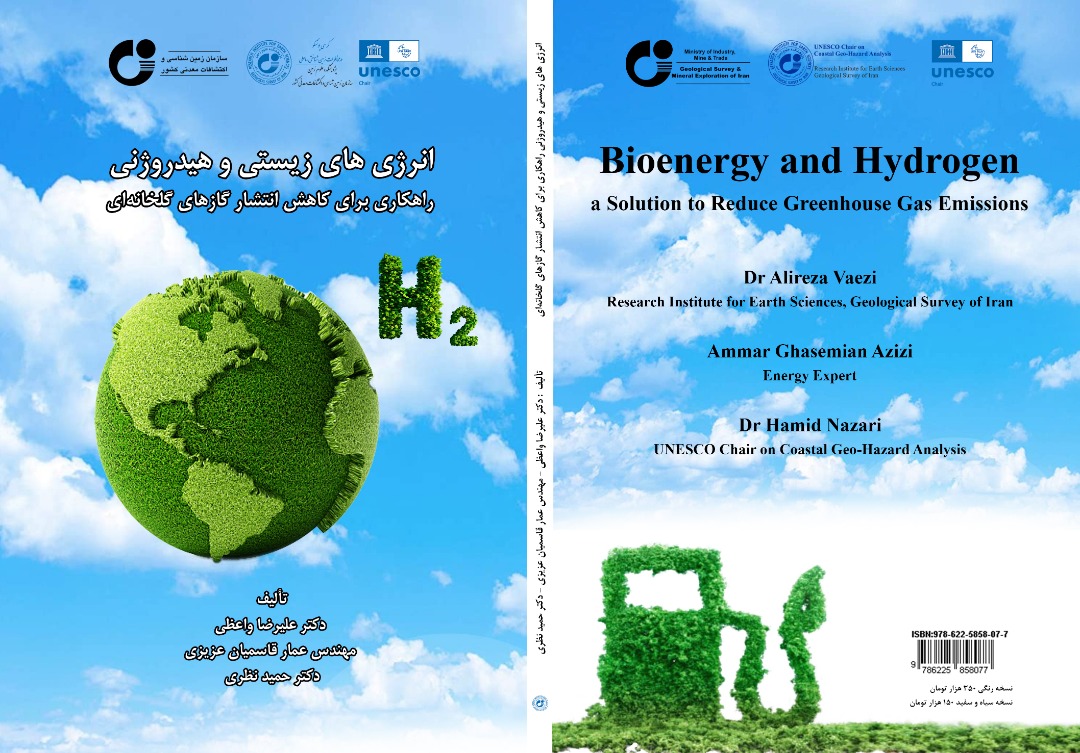By:
Dr. Alireza Vaezi
Research Institute for Eart Sciences,Geological Survey of Iran
Ammar Ghasenian Azizi
Energy Expert
Dr. Hmid Nazari
UNESCO Chairon Coastal Geo-Hazarh Analysis
Although the inhabitants of the earth played no part in the occurrence of the previous five global extinctions since 500 million years ago, but it would certainly not be unreasonable to assume that the start of the sixth global extinction could be due to bad human interaction on Earth in post-industrial times.
Earth's climate has changed throughout history due to natural causes such as changes in solar radiation, orbital motions, orogeny and ocean fluctuations. However, since the start of the Industrial Revolution in the 18th century, a sharp increase in greenhouse gas emissions (water vapor, carbon dioxide, methane, nitrogen oxides and ozone) has led to global warming and drastic changes in water conditions and availability (IPCC 2019). In particular, human activities related to the burning of fossil fuels have increased the level of carbon dioxide in the atmosphere from 280 ppm in 1750 to over 400 ppm in recent years (IPCC 2019, 2021). Since the 1970s, global average temperature data have shown a linear warming trend of about 0.9°C. Unlike temperatures, which have increased almost everywhere in the world, precipitation has a variable response, decreasing in some regions and increasing in others. Therefore, there is an ongoing debate about how global warming will affect future precipitation and major climate systems on Earth.
Regional and international assessments regarding the climatic future of the Persian Gulf coast have recently been presented. These temperature changes on the southern coasts of Iran has serious consequences. For example, a NASA study shows areas that will not be habitable for the next 30 years due to global warming. The increase in temperature compared to the pre-industrial era has serious consequences for the earth. Scientists believe that by 2050, the coasts of South Asia, including the coasts of Iran, Oman, Kuwait, as well as countries bordering the Red Sea such as Egypt, Saudi Arabia, Sudan, Ethiopia, Somalia or even Yemen will no longer be inhabited. South Asia, Brazil and US states such as Arkansas, Missouri and Iowa could meet a similar fate in 2070.
In its report, the Intergovernmental Panel on Climate Change warned of the consequences of global warming. These consequences include heat waves, drought, floods, fires and melting ice. One of the consequences of rising temperatures is felt on the economy, because if nothing is done, between 35 and 132 million people could be in extreme poverty by 2030.
The consequences of rising temperatures will be catastrophic for humanity. The repetition of the heat wave can gradually become more and more frequent. According to the Intergovernmental Panel on Climate Change, the effects of climate change on different regions will vary over time, with the ability of different social and environmental systems to mitigate or adapt to change. Increased droughts and fires, increased floods and adverse weather, melting ice and rising sea levels, collapse of agriculture and fisheries, disease outbreaks and epidemics, ecosystem disruptions and species extinction are important consequences that can result from increasing global temperatures.
All of these problems are expected to get worse by 2050. The only question is whether the situation will improve after getting worse or not? The difference between the two issues goes back to our efforts as a living species to deal with our habits and addictions. As research shows, our overall impact on the environment largely depends on our ability to limit carbon emissions. Although it is said that every problem has a solution, in many cases every potential solution has an opportunity. If you miss this opportunity, the problem will get worse and you will need to take more action. If humanity can significantly reduce its carbon emissions by 2050, we can expect climate change on our planet to be controlled.
If we cannot control these changes, we will have to wait for serious consequences. With all the changing and changing lives of our lives, we should logically expect the world of 2050 to be very different from today. In fact, it's safe to say that this difference will be enough to scare and amaze anyone alive today.
In any case, 2050 will inevitably arrive, and ignoring change is not an effective way to deal with it. What matters is what we are currently doing on the planet and how seriously we take the prospect of these changes. If we don't do our job well, things may get worse before they get better.
The 2015 Paris climate agreement (COP 21) as well as the United Nation Climate Change Conference in Glasgow 2021 (COP 26) aim to keep the rise in average temperature below 2°C and to continue "efforts" to limit it to 1.5°C. This is the only way to prevent adverse and unpredictable climate effects at local and regional scales (IPCC, 2021). The predicted results in this study show that southeast Iran is on a risky path by 2080 with a slight increase in temperature by 2080.
Although for the first time the number of deaths due to overnutrition is higher than that of victims of food poverty, and the number of deaths due to old age is higher than that of diseases and epidemics, there are clear signs of climate change with climate change. hurricanes, floods and devastating droughts, the human race against the great decision to find a balance between the concepts of development and sustainable development! By drawing a roadmap to save the earth, or in other words, to save the human species.
Growing energy needs, limited fossil fuels, greenhouse effects and global warming, as well as environmental pollution caused by the use of fossil fuels, have led to increasing attention being paid to renewable sources. Humans now have access to more innovative and cost-effective ways to absorb and store clean energy, and renewable energy has become a more important resource.
This book, entitled Biological and Hydrogen Energy, is a solution to reduce greenhouse gases in four chapters of 234 pages, the name of each chapter has been chosen according to the book that is currently of concern to human society. The first chapter, with the goal of achieving net-zero CO2 emissions by 2070, was titled “Technologies needed to achieve net-zero emissions”. In this chapter, specific technologies are introduced in order to transform the energy sector, and looking to 2070, it describes in detail the four technologies that lead to the storage of 50% of the cumulative CO2, and more energy efficiency and considers the use of renewable energy as the main pillars to achieve net zero emissions. In order to deal with global warming and its consequences, we must seek ways to reduce emissions from fossil fuels used in various industries or burned to generate electricity in power stations. More clean energy is needed to decarbonize. Then, by designing a model to shift more of the world's energy consumption to clean energy, that will lead to faster reductions in greenhouse gases and reaching net zero emissions, which is one of the goals of the Paris Agreement (2015). In this chapter of the book, we also try to assess the approach of clean energy technologies and in particular the energy transition necessary to achieve the development objectives of energy sustainability and the fight against global warming. According to the International Energy Agency, there are two different scenarios for the global energy outlook, and the model of achieving net zero emissions in the sustainable development scenario is discussed in detail below and briefly compared to the other scenarios. The CO2 emission model, energy efficiency benefits, long-term zero-emissions technologies, energy consequences, pollution reduction and emphasis on material efficiency in the scenario of sustainable development were also discussed. The following is a discussion of the prospects and readiness of low-carbon technology value chains, and the importance of addressing this issue is that the development of a new technology and its successful entry into the market is usually a long process. Technologies take a path in which they are transformed from prototype to prototype, then presented at a specific scale and, if successful, more widely accepted and commercialized. Finally, different levels of technology readiness will be assessed.
The second chapter describes the main decarbonization strategies in the sustainable development scenario. In order to apply decarbonization strategies, new technologies are needed; Technologies that should have reached the market stage and effective measures should be taken day by day to increase their efficiency and effectiveness. These technologies have been described in detail and the use of these technologies in various industries has also been discussed. In the following, we will examine the costs, investments and reduced external costs in the energy transition, which are major investments in the energy sector related to investments in renewable energy and energy efficiency.
The significant increase in the amount of investment required is mainly due to infrastructure development. However, the cost savings far outweigh the cost increase, due to air pollution costs, treatment costs, as well as injury costs. The environment is reduced due to emissions of CO2. The issue of health will save (on average) $6 trillion per year by 2050 from three times the additional cost of human carbon (a major driver of energy policy in many countries) and less CO2 emissions from fossil fuels. of decarbonization.
It also examines other benefits of implementing renewable energy and energy efficiency, including reduced water use, job creation and increased GDP, which together will drive to an overall improvement in well-being. The well-being index in this analysis accepted three dimensions of sustainable development: economic, social and environmental. This analysis also includes six sub-indices which are collected under the economic, social and environmental sub-indices of the general index of well-being, which were also examined.
Since in recent years, solar and wind energy in the country has received more attention and more material has been written in this regard, so this article focuses more on hydrogen and bioenergy and the chapter We have devoted the third and fourth to these two less known but very important issues for the future of world energy. It is expected that in the future the share and role of bioenergy alongside green hydrogen will be much greater. It is estimated that hydrogen and bioenergy will account for an average of 60% of global warming demand by 2070, while electricity will account for 20%. The share of sustainable biomass in primary energy demand will double to 20% by 2070, when it will be used to manufacture biofuels, transport, generate electricity and heat. In the perspective of the sustainable development scenario, bioenergy will lead to a 12% reduction in cumulative emissions.
Chapter 3 examines the role of biomass in reducing greenhouse gas emissions, in securing energy supply through renewable energy, which if improved climate and global policies can accelerate the development of this type of energy and the negative effects it prevents. Heat and energy from biomass It have been studied in different industries and regions around the world and compared traditional and modern biomass. Predict the state of the world's biomass resources, biomass resources, bioenergy conversion pathways, conversion options and landscape, conversion efficiency and application, local or large-scale conversion scale, bioenergetic stimuli and the effects of environmental bioenergy saturation were among the topics discussed. However, there is considerable debate on how to design and implement biomass use policies in each country, which is discussed later in this chapter. In the previous sections of the chapter, three different options are available to improve the use of biomass in the field of energy in terms of using its full potential as an energy source and enhancing its effects. positive on greenhouse gas emissions and the environment and the subject of climate, security of energy supply, etc. Another challenge has been described relying on the interpretation of these results in relation to improved policies that could accelerate these improvements, prevent adverse effects and ensure that the necessary measures are taken or take action. Also at the end of this chapter are statistical data published by the International Renewable Energy Agency between 2010 and 2020.
Chapter 4, entitled Hydrogen, tries to show the importance of the issue of hydrogen in the future of the world and marks the beginning of a serious step by the country to use it in the future energy basket of the country. The main subject of this chapter is green hydrogen. Transforming green hydrogen from an inefficient player in domestic and global markets into an important and influential sector in the energy market requires an integrated policy with an approach to counter initial resistance to hydrogen entry. hydrogen as an important part of the energy market. In order to achieve this goal, it is necessary to understand the important concepts that have been tried to be evaluated and clarified in this chapter of the book.
Next, the necessity of the roadmap for the use of hydrogen and hydrogen and its course until 2050 were examined. Academic studies and various engineering researches have led to the creation of different hydrogen production methods around the world. Each of these methods is different in terms of the amount of greenhouse gas emissions and also the relative potential of their competition with each other. Additionally, the type of technology selected and the source of energy supply in that selected technology has a significant impact on the cost of the hydrogen produced, which is a very important and key issue in the development of the selected method(s). In order to study this question, it is necessary first to identify the types of hydrogen according to its source of production, which has been discussed in detail. Due to the emerging interest in the use of hydrogen to reduce greenhouse gas emissions in order to prevent the intensification of climate change, the global or regional roadmap as well as the roadmap for Iran have a similar path because the world in This is the beginning of this path. For this reason, staying and procrastinating, especially the lack of technology in this field in the country, will cause us to be among the dependent and backward countries in this field in the future, and as we survived the global industrial revolution in the past and are still under impact, survival in this area in the future will have a tangible negative effect throughout the country for the future. For this reason, this question was one of the questions that was approached with a particular regard to the world and in particular to Iran.
Achieving the broad objectives mentioned in the previous sections is impossible without defining investment projects and communicating investment guidelines. The major countries sensitive to climate change, with the support of their central banks and other private banks, as well as the support of large investment companies, are increasingly developing and planning in this regard. Procrastination in this regard is considered technological backwardness. The development of these instructions must be carried out in a professional and binding manner. Therefore, this question was also important.
Related topics include a significant increase in hydrogen consumption and an increase in production capacity, the US Center for Climate and Energy Strategy report on hydrogen, the International Energy Agency report, the production of hydrogen from water and electricity, technologies in the field of water electrolysis, thermal routes for hydrogen production with emphasis on nuclear energy, storage and distribution of hydrogen by transfer, industrial applications of hydrogen and future potentials focused on industries such as oil refineries, petrochemicals and steel industries that make a significant contribution to There are many challenges in industry and economy of Iran, challenges of using hydrogen as a heat source, opportunities of using hydrogen in transportation, construction and production action, private and public sector initiatives to use hydrogen in transport Roads are the cornerstone of the development of policies in favor of green hydrogen.
According to the contents of this book, the primary audience for this book are politicians and senior executives from major industries such as oil, gas, petrochemicals, and steel. Academic and research scholars can also use the contents of this book to study the future vision document of this energy and use it as a basis for their future research.








